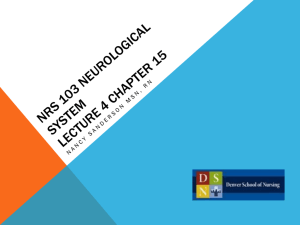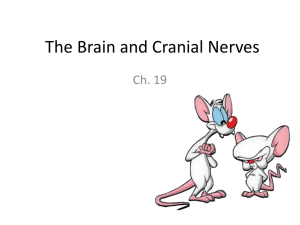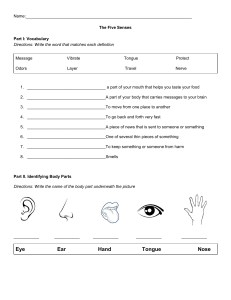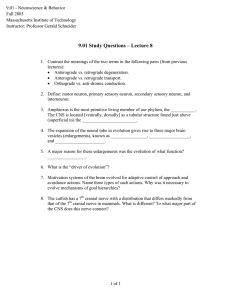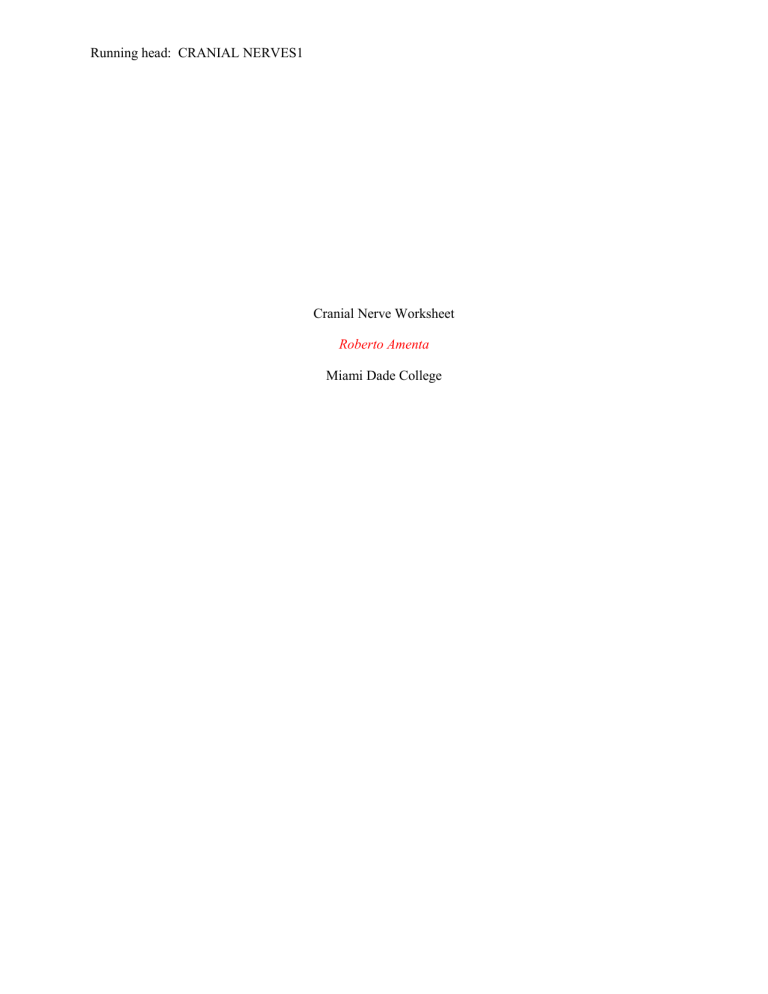
Running head: CRANIAL NERVES1 Cranial Nerve Worksheet Roberto Amenta Miami Dade College CRANIAL NERVES2 CRANIAL NERVES CHART WORKSHEET Please fill in the name of the cranial nerve, whether the nerve is motor or sensory or both, and how you would assess the function of the nerve. Name of Cranial Nerve I Olfactory Nerve Motor or Sensory or Both Sensory II Optic Nerve Sensory III Oculomotor Nerve Motor IV Trochlear Nerve Motor V Trigeminal Nerve Both VI Abducens Nerves Motor VII Facial Nerve Both VIII Acoustic Nerve Sensory How this nerve is assessed Close patients eyes and occlude one nostril and present aromatic substance. Using ophtalmoloscope to assess the ocular fundus and determine color, size and shape of the optic disc. Test visual acuit and visual fields. Using a pen light do light reflex testing. Shine light directed at one eye- the CNIII nerve should constrict pupils on both eyes. Ask patient to follow your finger while you move it towards his nose. Motor function: palpate temporal and masseter muscles as patient clentches the teeth. Muscles should feel equally strong. Sensory function: With patients eyes closed, assess touch sensation of the forehead, cheeks and chin. Ask patient to look towards each of his ears. After, have patients follow your finger through the six carnidals fields of gaze. Motor function: Note mobility and facial symmetry as the patients responds to requests: smile, frown, close eyes tightly, lift eyebrows, show teeth and puff cheeks. Sensory function: Taste buds on the anterior two thirds of the dorsal region of the tongue are innervated by the CNVII Hearing acuity determined by the ability of patient to hear normal conversation. CRANIAL NERVES3 IX Both Glossopharyngeal Nerve Can also be tested by the whispered voice test. Motor function: Depress patient's tongue with a tongue blade and note pharyngeal movement as patient says "aahh"- uvual and soft palate should rise in the midline. Sensory function: Touch posterior pharyngeal wall with a cotton applicator stick and note presence of pharyngeal sensation. X Vagus Nerve Both XI Spinal Accessory Nerve Motor XII Hypoglossal Nerve Motor Motor function: Depress patient's tongue with a tongue blade and note pharyngeal movement as patient says "aahh"- uvual and soft palate should rise in the midline. Sensory function: Touch posterior pharyngeal wall with a cotton applicator stick and note presence of pharyngeal sensation. Examine sternomastoid and trapezius muscle for equal size. Check equal strenght by asking patient to rotate the head forcibly against resistance applied to chin. Inspect tongue. No wasting or tremors should be present. Note the forwards thrust in the midline as the preson protrudes the tongue. Ask patient to say "light, tight, dynamite" and note the lingual speech. MEMORY TRIGGERS – ON OLD OLYMPUS TOWERING TOPS A FINN AND GERMAN VIEWED SOME HOPS. S=SENSORY M=MOTOR B=BOTH I II III IV V VI VII VIII IX X XI SOME SAY MARRY MONEY BUT MY BROTHER SAYS BIG BUSINESS MAKES MONEY XII CRANIAL NERVES4 Reference Admin. (2021, March 11). Facing cranial nerve assessment. American Nurse. Retrieved September 17, 2022, from https://www.myamericannurse.com/facing-cranial-nerveassessment/#:~:text=To%20assess%20the%20trochlear%20nerve,it%20down%20toward%20his%20nos e.&text=Cranial%20nerve%20V%20covers%20most,areas%20of%20the%20trigeminal%20nerve. How to conduct a cranial nerve examination: Postgraduate Dentistry. Online Dental Programs. (2022, July 11). Retrieved September 17, 2022, from https://ostrowon.usc.edu/cranial-nerveexamination/#:~:text=The%20facial%20motor%20nerve%20supplies,cheeks%20and%20reveal%20their %20teeth. Jarvis, C., Eckhardt, A., & Thomas, P. (2020). Physical Examination & Health Assessment. Elsevier.

